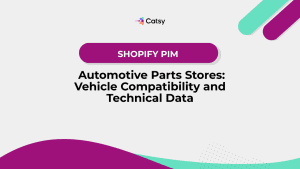Automotive PIM: Shopify Parts Stores: Vehicle Compatibility and Technical Data

Chart Your Automotive Course
What You’ll Learn:
- Essential PIM strategies for automotive parts compatibility management
- Technical data organization systems that improve customer experience and reduce returns
- Vehicle fitment database integration approaches for Shopify platforms
- Operational frameworks that handle OEM, aftermarket, and universal parts effectively
In this Article
Automotive PIM: Your Critical Navigation Foundation
For automotive parts retailers operating on Shopify Product Information Management (PIM) represents far more than basic catalog organization. Product Information Management is the technical compass that determines both your user’s experience and your own operational efficiency.
Unlike general retail, automotive parts are highly specific, and they require precise compatibility data. Detailed tech specs and complex cross-referencing capabilities are also essential to your data management systems.
What is Automotive PIM?
Automotive PIM encompasses the systematic management of your product related information. This data is specific to auto parts, including vehicle compatibility, tech specs, part numbers, fitment data, and installation requirements. It also considers the relationships between OEM and universal components across thousands of vehicle variations.
The automotive industry has a vast ecosystem where a single part category might contain hundreds of variations. These variants are designed for specific year, make, model, and engine combinations!
Each part requires accurate fitment data and often multiple part numbers from different manufacturers. As you can imagine, this creates a lot of data management challenges, especially as you scale!
Why Precision Data Management Has Become Essential for Charting Automotive Success
One wrong part can cause a lot of customer problems. Costly returns and potential safety concerns are two examples. In other categories, an incorrect delivery can cause disappointment. In your industry, the wrong part can cause vehicle damage, safety risks, and even legal challenges.
When you implement a robust PIM, you’re creating the foundation for consumer confidence and operational efficiency. Accurate fitment data benefits you: it reduces returns, improves customer satisfaction, and simplifies processes for your shoppers.
Online automotive shopping has evolved, and your customers have high expectations. Today’s customer wishes to enter their vehicle’s make, model, body style, and year of manufacture – once – to view compatible parts. Detailed technical specifications and installation guidance increase confidence.
Meeting these expectations requires sophisticated data management that goes far beyond basic product catalogs.
Make Catsy DAM and PIM Software an Extension of Your Team
Book a Free DemoVehicle Compatibility Matrix: Setting Your Fitment Coordinates
Multi-Dimensional Fitment Data:
Finding the right part for a vehicle includes assessment of year ranges, engine types, transmission variations, trim levels, option packages, and much more! An effective PIM system should manage these relationships effectively while providing customers with fast and accurate lookups.
Universal vs. Specific Fitment:
Parts inventory typically includes components with universal fitment and with specific vehicle applications. Conditional compatibility exists, also, and is based on vehicle configurations.
Your PIM must distinguish between these categories while also providing clear guidance to customers about the relevance of each part and about any required modifications.
OEM and Aftermarket Cross-Referencing:
Automotive parts often have multiple part numbers. That could include those from equipment manufacturers, aftermarket suppliers, and superseded versions.
Effective PIM management maintains these cross-references while helping customers understand compatibility between the different brands and part number systems.
Fitment Exception Management:
A lot of automotive parts have exceptions to general fitment rules. Production dates, specific options, and regional variations may be factors. PIM systems should handle these exceptions accurately to avoid customer confusion.
Technical Data Organization: Charting Information Waters
Specifications Database Architecture: Automotive parts require extensive technical specifications including dimensions, materials, performance ratings, and compatibility requirements. PIM systems must organize this information for easy maintenance while presenting it clearly to customers with varying technical expertise levels.
Installation and Service Information: Many automotive parts require installation guidance, torque specifications, special tools, or additional components. PIM systems must integrate this information with product data while making it accessible to customers and service professionals.
Safety and Compliance Data: Automotive parts often involve safety certifications, environmental compliance, and regulatory requirements that vary by region and application. PIM systems must maintain this information accurately while presenting appropriate warnings and compliance information to customers.
Performance and Application Data: Aftermarket automotive parts frequently offer performance improvements or specific application benefits that require detailed explanation. PIM systems must present this information effectively while maintaining clear distinctions between OEM replacement and performance upgrade applications.
Integration Challenges: Navigating Shopify Platform Waters
Native Shopify Limitations:
Standard Shopify wasn’t designed to support complex compatibility relationships that auto parts require. To successfully implement product information management, custom coding is sometimes required. Third party apps also exist that can integrate into your platform.
Alternatively, you can take a hybrid approach to combine Shopify’s e-commerce capabilities with specialized auto parts data management systems.
Search and Discovery Optimization:
Your customers need to find parts through multiple pathways. Consider implementing vehicle lookup, part number search, compatibility filtering, and basic browsing into your platform. Ensure that adding these capabilities doesn’t impact your site’s performance – test, test, test!
Inventory Management Complexity:
Automotive parts often have complex inventory considerations. Seasonal demand, supplier availability, and regional variations are a few. PIM integration should coordinate with your inventory management, all while providing accurate data to your customers.
Customer Account Integration:
Business-to-business automotive customers often need account-specific pricing. They may also have compatibility preferences (for instance, a Dodge-specific repair shop). Furthermore, your customer appreciates an order history that reflects their fleet.
Your PIM system should integrate with customer management but still maintain personalized experiences.
Top 5 Strategies for Charting Automotive PIM Success
- Start with Clean, Standardized Data: Automotive PIM success depends wholly on your data quality and consistency. Make a significant effort to clean up your data, standardize formats, and create logical taxonomies for your parts. Poor data creates ongoing problems – garbage in, garbage out.
- Design for Customer Journey Optimization: Understand how your different customer types search for and evaluate your products. DIY customers, professional mechanics, and fleet managers may all have different habits. Design your PIM structure to support these different pathways while maintaining accuracy and ease of use across all customer segments.
- Implement Robust Validation Systems: Multiple validation layers prevents errors. Establish automated checking for logical consistency. Then, implement manual review processes for complex applications and use your feedback mechanisms to capture real-world fitment issues.
- Plan for Supplier Data Integration: Your automotive parts data likely comes from multiple suppliers. Chances are, each of these suppliers uses different formats, standards, and update frequencies. Your integration processes can be designed to handle this variety while still maintaining data quality and timeliness.
- Build Scalable Maintenance Workflows: Automotive PIM requires ongoing maintenance! As new vehicles are introduced, parts are superseded, and fitment information is updated, you’ll need to scale. Establish workflows that can handle these changes without disrupting the customer experience.
Real-World Automotive PIM Implementation Success Stories
Performance Parts Retailer Transformation
A performance automotive parts supplier struggled with customer returns. Fitment confusion and difficulty in finding compatible upgrades were the two primarily cited reasons for initiating a return.
Their PIM implementation created vehicle-specific shopping experiences that showed only compatible performance parts… all while providing detailed comparison information between options. The system integrated tech specs with customer reviews and installation guides, dramatically reducing returns while improving customer satisfaction.
Professional Service Parts Distribution
A wholesale parts distributor served professional repair shops, and needed to provide detailed technical information as well as a quick lookup option.
Their PIM solution integrated with their legacy systems while providing comprehensive compatibility databases. Technical service bulletins and OEM cross-reference information was readily available to customers, allowing for quick ID and reduced order errors.
Multi-Brand Aftermarket Retailer
A large aftermarket parts retailer managing multiple brand relationships needed to consolidate compatibility data from different suppliers while maintaining brand-specific information.
Their PIM implementation created unified vehicle compatibility databases while preserving supplier-specific technical data, installation guides, and warranty information.
These implementations demonstrate that successful automotive PIM systems solve specific business problems. This improves both operational efficiency and customer experience through better data management and presentation.
Working with Automotive PIM Navigators
Implementing effective automotive PIM requires expertise in the industry! Complex data management must seamlessly integrate with e-commerce technology.
The specialized nature of automotive compatibility data often exceeds internal capabilities for companies that are focused on parts distribution rather than technology development.
Professional automotive PIM specialists understand the unique challenges of vehicle compatibility management and the customer experience requirements that automotive retail demands. They bring experience – they know how to implement and they can help avoid common pitfalls throughout the integration process and beyond.
When evaluating potential partners, prioritize those with demonstrated experience in automotive retail, complex data integration projects, and ongoing support capabilities.
Key Takeaways
- Automotive PIM requires specialized approaches that address vehicle compatibility complexity well beyond standard e-commerce capabilities
- Your success depends on clean, standardized data combined with robust validation systems and maintenance workflows
- Customer experience optimization requires understanding different user types and their specific search and discovery needs
- Platforms like Catsy PIM provide automotive-specific functionality for managing complex vehicle compatibility data, technical specifications, and supplier integrations
- Integration with existing systems and supplier data feeds demands careful architectural planning and ongoing management
- Professional expertise is often essential for managing the technical complexity and industry-specific requirements effectively
Want more tips, tutorials, and insights on product content and e-commerce operations?
Stay connected. We post regularly to help brands like yours scale smarter.
Are You Ready To streamline your product content management?

Frequently Asked Questions
Effective fitment management requires hierarchical data structures. These organize vehicles by logical groupings while maintaining compatibility exceptions.
Begin by establishing consistent vehicle identification standards, then build your compatibility matrices. These should be able to handle both board and specific fitment patterns. Use validation systems to check for logical consistency.
Supplier data integration requires flexible ETL processes (Extract, Transform, Load). These processes can normalize different data formats into consistent internal standards.
Establish mapping protocols that are specific to each supplier. Use validation rules to catch inconsistencies and create exception handling. Communicate regularly with suppliers about data quality issues, then use this feedback to improve.
Multiple validation layers means improvement in prevention. Logical checking and manual review processes should be implemented.
Implement clear presentation of fitment information with appropriate disclaimers. Provide easy return processes for genuine errors, and use return data to identify and correct systematic fitment issues within your database.
This depends upon your technical resources, your budget, and your specific business. Custom solutions offer maximum flexibility – but they may require significant development and maintenance. Similarly, specialized automotive PIM platforms provide proven functionality but may require adaptation to your specific needs.
Many successful implementations use a hybrid approach that combines specialized automotive data management with standard e-commerce platforms through API integrations.
Subscribe For More Content
Sign up for monthly tips on how to drive revenue with product content.




